Changan Chen
Experience is the Best Teacher: Grounding VLMs for Robotics through Self-Generated Memory
Jul 22, 2025Abstract:Vision-language models (VLMs) have been widely adopted in robotics to enable autonomous planning. However, grounding VLMs, originally trained on internet data, to diverse real-world robots remains a challenge. This paper presents ExpTeach, a framework that grounds VLMs to physical robots by building a self-generated memory of real-world experiences. In ExpTeach, the VLM autonomously plans actions, verifies outcomes, reflects on failures, and adapts robot behaviors in a closed loop. The self-generated experiences during this process are then summarized into a long-term memory, enabling retrieval of learned knowledge to guide future tasks via retrieval-augmented generation (RAG). Additionally, ExpTeach enhances the spatial understanding of VLMs with an on-demand image annotation module. In experiments, we show that reflection improves success rates from 36% to 84% on four challenging robotic tasks and observe the emergence of intelligent object interactions, including creative tool use. Across extensive tests on 12 real-world scenarios (including eight unseen ones), we find that grounding with long-term memory boosts single-trial success rates from 22% to 80%, demonstrating the effectiveness and generalizability of ExpTeach.
Interspatial Attention for Efficient 4D Human Video Generation
May 21, 2025Abstract:Generating photorealistic videos of digital humans in a controllable manner is crucial for a plethora of applications. Existing approaches either build on methods that employ template-based 3D representations or emerging video generation models but suffer from poor quality or limited consistency and identity preservation when generating individual or multiple digital humans. In this paper, we introduce a new interspatial attention (ISA) mechanism as a scalable building block for modern diffusion transformer (DiT)--based video generation models. ISA is a new type of cross attention that uses relative positional encodings tailored for the generation of human videos. Leveraging a custom-developed video variation autoencoder, we train a latent ISA-based diffusion model on a large corpus of video data. Our model achieves state-of-the-art performance for 4D human video synthesis, demonstrating remarkable motion consistency and identity preservation while providing precise control of the camera and body poses. Our code and model are publicly released at https://dsaurus.github.io/isa4d/.
Learning Activity View-invariance Under Extreme Viewpoint Changes via Curriculum Knowledge Distillation
Apr 07, 2025Abstract:Traditional methods for view-invariant learning from video rely on controlled multi-view settings with minimal scene clutter. However, they struggle with in-the-wild videos that exhibit extreme viewpoint differences and share little visual content. We introduce a method for learning rich video representations in the presence of such severe view-occlusions. We first define a geometry-based metric that ranks views at a fine-grained temporal scale by their likely occlusion level. Then, using those rankings, we formulate a knowledge distillation objective that preserves action-centric semantics with a novel curriculum learning procedure that pairs incrementally more challenging views over time, thereby allowing smooth adaptation to extreme viewpoint differences. We evaluate our approach on two tasks, outperforming SOTA models on both temporal keystep grounding and fine-grained keystep recognition benchmarks - particularly on views that exhibit severe occlusion.
SocialGen: Modeling Multi-Human Social Interaction with Language Models
Mar 28, 2025Abstract:Human interactions in everyday life are inherently social, involving engagements with diverse individuals across various contexts. Modeling these social interactions is fundamental to a wide range of real-world applications. In this paper, we introduce SocialGen, the first unified motion-language model capable of modeling interaction behaviors among varying numbers of individuals, to address this crucial yet challenging problem. Unlike prior methods that are limited to two-person interactions, we propose a novel social motion representation that supports tokenizing the motions of an arbitrary number of individuals and aligning them with the language space. This alignment enables the model to leverage rich, pretrained linguistic knowledge to better understand and reason about human social behaviors. To tackle the challenges of data scarcity, we curate a comprehensive multi-human interaction dataset, SocialX, enriched with textual annotations. Leveraging this dataset, we establish the first comprehensive benchmark for multi-human interaction tasks. Our method achieves state-of-the-art performance across motion-language tasks, setting a new standard for multi-human interaction modeling.
The Language of Motion: Unifying Verbal and Non-verbal Language of 3D Human Motion
Dec 13, 2024Abstract:Human communication is inherently multimodal, involving a combination of verbal and non-verbal cues such as speech, facial expressions, and body gestures. Modeling these behaviors is essential for understanding human interaction and for creating virtual characters that can communicate naturally in applications like games, films, and virtual reality. However, existing motion generation models are typically limited to specific input modalities -- either speech, text, or motion data -- and cannot fully leverage the diversity of available data. In this paper, we propose a novel framework that unifies verbal and non-verbal language using multimodal language models for human motion understanding and generation. This model is flexible in taking text, speech, and motion or any combination of them as input. Coupled with our novel pre-training strategy, our model not only achieves state-of-the-art performance on co-speech gesture generation but also requires much less data for training. Our model also unlocks an array of novel tasks such as editable gesture generation and emotion prediction from motion. We believe unifying the verbal and non-verbal language of human motion is essential for real-world applications, and language models offer a powerful approach to achieving this goal. Project page: languageofmotion.github.io.
Action2Sound: Ambient-Aware Generation of Action Sounds from Egocentric Videos
Jun 13, 2024


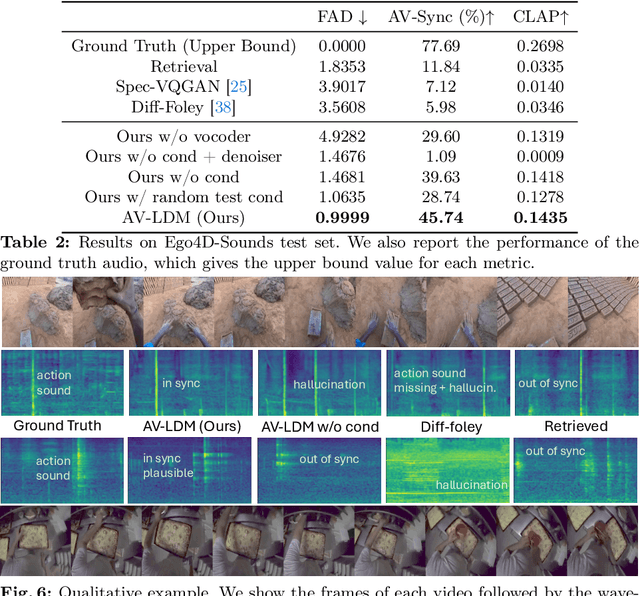
Abstract:Generating realistic audio for human interactions is important for many applications, such as creating sound effects for films or virtual reality games. Existing approaches implicitly assume total correspondence between the video and audio during training, yet many sounds happen off-screen and have weak to no correspondence with the visuals -- resulting in uncontrolled ambient sounds or hallucinations at test time. We propose a novel ambient-aware audio generation model, AV-LDM. We devise a novel audio-conditioning mechanism to learn to disentangle foreground action sounds from the ambient background sounds in in-the-wild training videos. Given a novel silent video, our model uses retrieval-augmented generation to create audio that matches the visual content both semantically and temporally. We train and evaluate our model on two in-the-wild egocentric video datasets Ego4D and EPIC-KITCHENS. Our model outperforms an array of existing methods, allows controllable generation of the ambient sound, and even shows promise for generalizing to computer graphics game clips. Overall, our work is the first to focus video-to-audio generation faithfully on the observed visual content despite training from uncurated clips with natural background sounds.
HOI-Swap: Swapping Objects in Videos with Hand-Object Interaction Awareness
Jun 11, 2024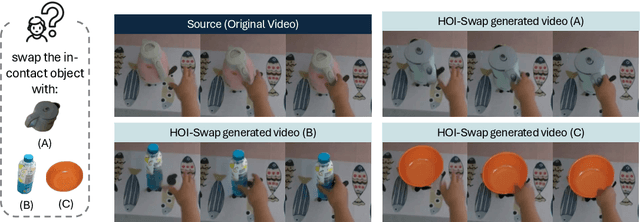


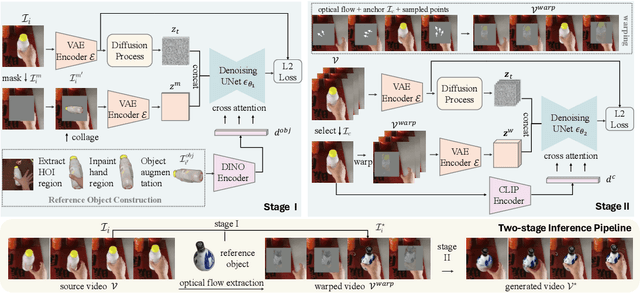
Abstract:We study the problem of precisely swapping objects in videos, with a focus on those interacted with by hands, given one user-provided reference object image. Despite the great advancements that diffusion models have made in video editing recently, these models often fall short in handling the intricacies of hand-object interactions (HOI), failing to produce realistic edits -- especially when object swapping results in object shape or functionality changes. To bridge this gap, we present HOI-Swap, a novel diffusion-based video editing framework trained in a self-supervised manner. Designed in two stages, the first stage focuses on object swapping in a single frame with HOI awareness; the model learns to adjust the interaction patterns, such as the hand grasp, based on changes in the object's properties. The second stage extends the single-frame edit across the entire sequence; we achieve controllable motion alignment with the original video by: (1) warping a new sequence from the stage-I edited frame based on sampled motion points and (2) conditioning video generation on the warped sequence. Comprehensive qualitative and quantitative evaluations demonstrate that HOI-Swap significantly outperforms existing methods, delivering high-quality video edits with realistic HOIs.
Sim2Real Transfer for Audio-Visual Navigation with Frequency-Adaptive Acoustic Field Prediction
May 05, 2024Abstract:Sim2real transfer has received increasing attention lately due to the success of learning robotic tasks in simulation end-to-end. While there has been a lot of progress in transferring vision-based navigation policies, the existing sim2real strategy for audio-visual navigation performs data augmentation empirically without measuring the acoustic gap. The sound differs from light in that it spans across much wider frequencies and thus requires a different solution for sim2real. We propose the first treatment of sim2real for audio-visual navigation by disentangling it into acoustic field prediction (AFP) and waypoint navigation. We first validate our design choice in the SoundSpaces simulator and show improvement on the Continuous AudioGoal navigation benchmark. We then collect real-world data to measure the spectral difference between the simulation and the real world by training AFP models that only take a specific frequency subband as input. We further propose a frequency-adaptive strategy that intelligently selects the best frequency band for prediction based on both the measured spectral difference and the energy distribution of the received audio, which improves the performance on the real data. Lastly, we build a real robot platform and show that the transferred policy can successfully navigate to sounding objects. This work demonstrates the potential of building intelligent agents that can see, hear, and act entirely from simulation, and transferring them to the real world.
ActiveRIR: Active Audio-Visual Exploration for Acoustic Environment Modeling
Apr 24, 2024



Abstract:An environment acoustic model represents how sound is transformed by the physical characteristics of an indoor environment, for any given source/receiver location. Traditional methods for constructing acoustic models involve expensive and time-consuming collection of large quantities of acoustic data at dense spatial locations in the space, or rely on privileged knowledge of scene geometry to intelligently select acoustic data sampling locations. We propose active acoustic sampling, a new task for efficiently building an environment acoustic model of an unmapped environment in which a mobile agent equipped with visual and acoustic sensors jointly constructs the environment acoustic model and the occupancy map on-the-fly. We introduce ActiveRIR, a reinforcement learning (RL) policy that leverages information from audio-visual sensor streams to guide agent navigation and determine optimal acoustic data sampling positions, yielding a high quality acoustic model of the environment from a minimal set of acoustic samples. We train our policy with a novel RL reward based on information gain in the environment acoustic model. Evaluating on diverse unseen indoor environments from a state-of-the-art acoustic simulation platform, ActiveRIR outperforms an array of methods--both traditional navigation agents based on spatial novelty and visual exploration as well as existing state-of-the-art methods.
SoundingActions: Learning How Actions Sound from Narrated Egocentric Videos
Apr 08, 2024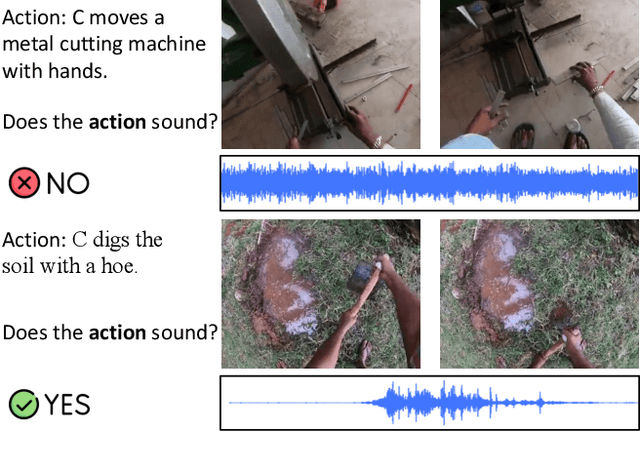

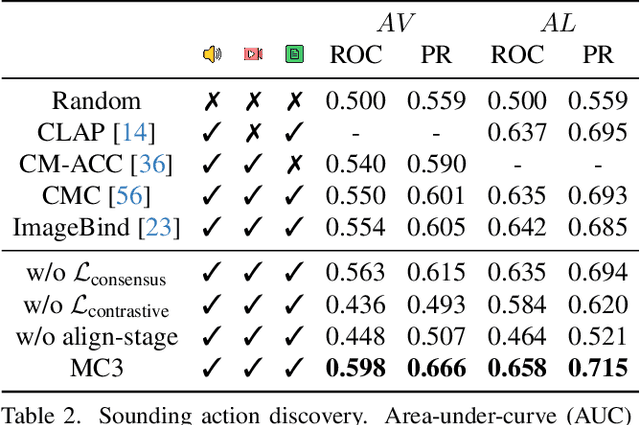

Abstract:We propose a novel self-supervised embedding to learn how actions sound from narrated in-the-wild egocentric videos. Whereas existing methods rely on curated data with known audio-visual correspondence, our multimodal contrastive-consensus coding (MC3) embedding reinforces the associations between audio, language, and vision when all modality pairs agree, while diminishing those associations when any one pair does not. We show our approach can successfully discover how the long tail of human actions sound from egocentric video, outperforming an array of recent multimodal embedding techniques on two datasets (Ego4D and EPIC-Sounds) and multiple cross-modal tasks.
 Add to Chrome
Add to Chrome Add to Firefox
Add to Firefox Add to Edge
Add to Edge